We hope you enjoy the articles and short stories presented here, and will join Kate in her adventures for many years to come.
Upon request, you will receive an inscribed copy of Kate Tattersall Adventures in China with every donation of $10 or more plus shipping. Please use the Contact Page to provide your shipping address and we will reply with your total.
The history of sunshades goes back thousands of years, but it was during the Italian Renaissance of the 16th century that umbrellas and parasols were introduced to Europe. At first the items were large, used interchangeably, and generally carried by a servant to protect the wealthy from the elements and sun. Some were heavy (made of leather) but silk, paper, and cotton grew in popularity. During the 1700s parasols had already evolved into a woman’s fashion item, designed and decorated to match each promenade dress or walking suit, and was clearly defined as a sunshade; not for rain and snow. To make them collapsible developed around 1800, but ribs would break, paper tear, and the materials mildew if left damp. By the early Victorian era metallurgy had improved and alloy ribs were being used, nickel silver particularly popular. This type of thin strong metal was developed in Germany by craftsmen in an attempt to imitate the Chinese combination of copper, nickel and zinc, known as paktong.
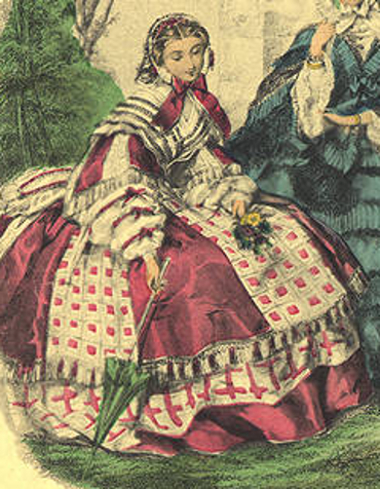
“Americanized Parisian outdoor dress, 1845” reveals that the enormous hooped skirts and small bonnets were popular in the United States before England. Note the tiny parasol.
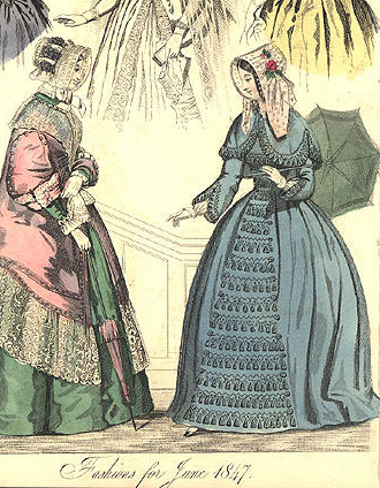
This 1847 example shows similar parasols. Small, long handled, different colours for various outfits, likely crafted of silk with nickel silver ribs. Unfortunately not much detail can be seen in any of these fashion plates.
At the beginning of Queen Victoria’s reign the parasols were quite plain, but by about 1850 tassels and frills grew in popularity. In each ensuing year the adornments became more ostentatious. If a dress had bows or flounces, the parasol could be adorned with the same decoration. This was a matter of taste, and ladies selected modest or extravagant versions for different circumstances, and based on what their income would allow. Of course it was only the wealthy who used parasols as a day-to-day accoutrement. A poor girl might have a simple parasol for church, or a Sunday afternoon stroll. It was during the 1850s the marquise parasol was developed, a style that tipped at the top, so a lady could hold the shaft straight and still shade her face well no matter the angle of the sun.
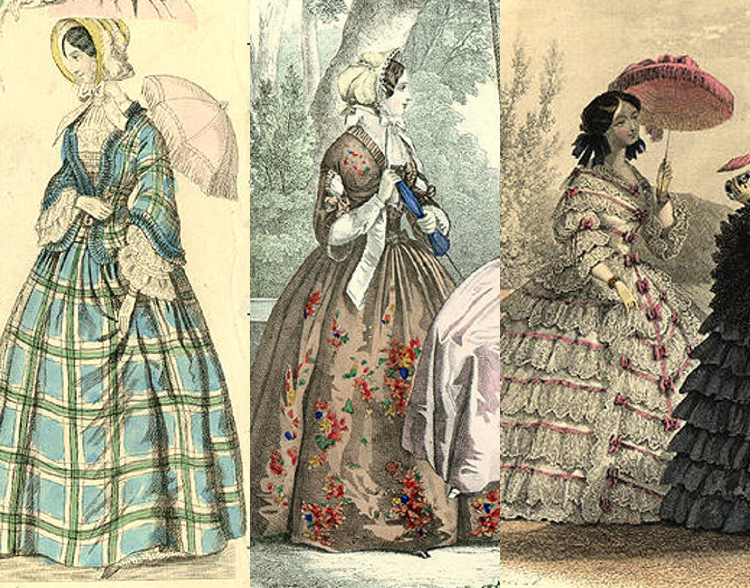
Day dress 1850, outdoor dress 1853, and a promenade dress 1855.
(Note that in all the fashion plates above the ladies are depicted with just a parasol and not a handbag. Purses, often called reticules, were only starting to grow in popularity in the mid 1800s. Large pockets were sewn into their voluminous skirts and they also carried baskets. In the winter their muffs served as a storage space. Wealthy ladies would often be accompanied by a maid who carried anything their mistress may require.)
During this time many houses featured racks (two horizontal parallel arms) for placing open parasols and umbrellas high overhead in front and back halls; ideal for implements that didn’t close, could be damaged by constant opening and closing, or damp items. Parasol handles were usually straight, but some hooked examples exist. A plain parasol might have a wooden or metal pole with a bone handle, while the most expensive choices were of carved ivory shafts, decorated with inlaid jewels and gold banding. An in between version could be with carved horn and silver filigree accents. Throughout the Victorian era the handles grew longer, so “carriage” parasols were designed with a hinge in the middle to allow breakdown and ease of movement in tight spots.
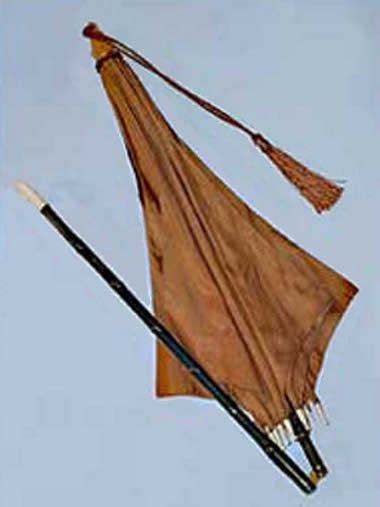
An 1850 example, quite plain, the hinge is clearly visible on the wood shaft, perhaps an ivory tip, the silk has held up very well over the years.
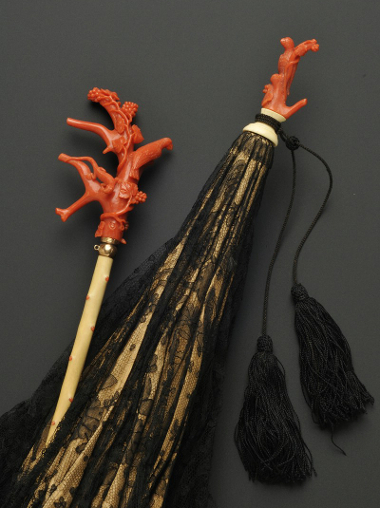
An exquisite mid 19th C model, black lace over cream silk, exotic carved coral accents, ivory pole with cabochon coral studs, engraved gold metal mounts.
Something of great interest to adventuresses (like Kate Tattersall), parasols and umbrellas could be purchased as weapons for self defence. In the Official Catalogue of the Great Exhibition of the Works of Industry of All Nations 1851, on page 145 it lists; “A new patent parasol, travelling umbrella, with folding handle, stiletto or defensive.” This Mr. Boss of Bury St. may have been making regular parasols and umbrellas, but also offered a combination model with the stiletto tip for travelling in dangerous circles. Perhaps the handle pulled off to reveal a blade secreted inside the pole?
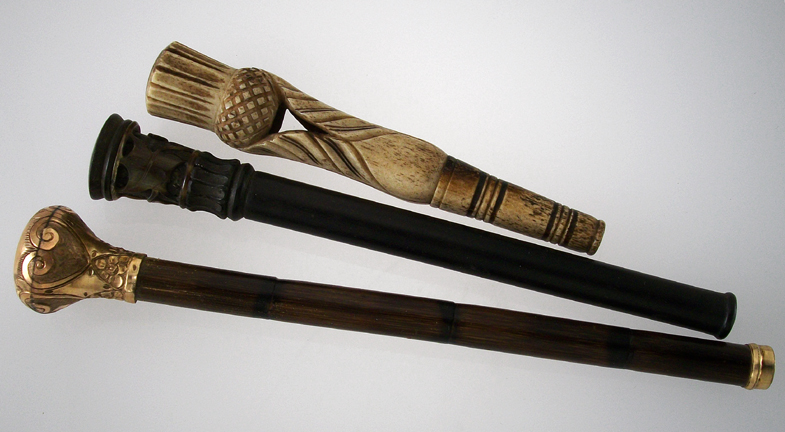
Handles, from top to bottom; carved bone thistle, carved horn and wood, and rolled gold on bamboo.

Very neat. I had no idea women were so bold as to carry parasols that also served as weapons.
Interesting. I would be very nervous around my wife if she had a parasol like this at her side.
re:Kaley: during the heyday of English firearms, women often even carried prayerbooks that contained small, folding pistols, for self-defense. I imagine they preached from “Exodus” a great deal in those days.
Parasols are so cute. I wish I could have one.
I would like a ‘cute’ parasol too, but that’s also a weapon for self-defence!
Great post. Lots of great info on this website.
Great article. Some questions though. Are there any other everyday objects women used back then that hid weapons? Was there a way for them to conceal guns? Or, I suppose to summarize, how did Victorian women defend themselves? Seriously, I mean defend themselves without a man since seeing the thing with the parasol there might be more self-defense weapons for women that was created.
@ Audrey, small pistols were made for women to carry in pockets and reticules (purses), and hollow books carried on trains and carriages. A cane, umbrella, or parasol could have a blade hidden within the shaft.
re: R.S. Fleming: Oh, I see. Thank you for the information.
How very informative. Thank you for sharing. I just acquired an antique parasol to list in my shop and had no idea how old it would be but you have given some helpful info. I will also be checking if it has a blade inside it. I’ve heard that the measurement of the length of the shaft can also help to date it.
Many thanks
Angela Zwartjens
Thank you for the helpful information. I just acquired an antique parasol for myself which is beautiful but very different than any others I have seen. Because of its size and carved handle it was just something I had to have. Your information helped me understand the time period.
Not sure what the small hoop on the end of the handle was used for, but very much like the detail using small thread and bead to secure it closed around the metal ends of its frame.
Greatly appreciate your help!
A small hoop is probably for hanging the parasol up when not in use.
I found a really well preserved beautiful old crocheted parasol, about 24″ in diameter, with a nice wooden shaft and split bamboo ribs. I gave it as a gift to a lady friend who carries it when she attends various heritage society functions wearing 18th & 19th century dresses.
I stumbled on your website and am so glad Lots of interesting information! I watched the series Bolivar recently and loved the rattan parasols used in the series. I would like to find one to purchase but don’t know how to locate? My search has been unsuccessful so far.
I have a parasol business called paraSals! I custom paint and embellish rice paper/bamboo skeleton/shaft and sell them at a local market (until it closed d/t Covid-19). I love parasols and love to see them becoming popular again! What relief they provide from the sun in sunny Florida!
Thanks for posting this, I’ve been doing research as right now I’m writing a story set in the Victorian Era (1850s~ ish) and there’s a female character, a higher-born lady that carries one around. I really just needed a detail about whether or not the parasols can fold in/close, but your article is interesting and I learned a lot of extra details. Thank you so much, I’ll probably continue to use your site bunches.
What a different Website. I design Walking Canes and I have used Victorian Parasol Handle for these.
Hello. I have acquired an antique item, a parasol. I have yet to figure out what I will do with it, either put it up for sale or keep it for my own for personal use. This article has been very beneficial to me and now I know how valuable the parasol is. Thank you very much.